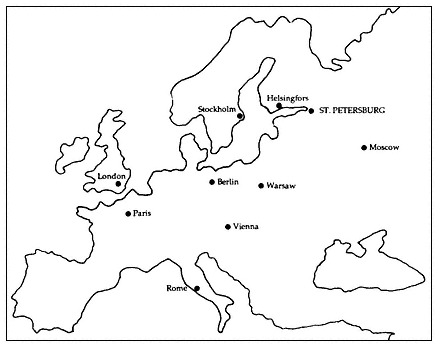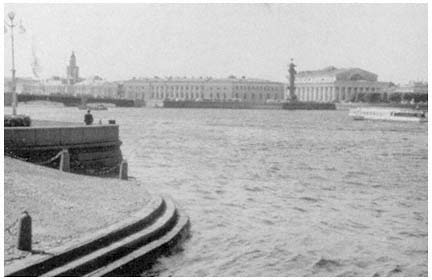A Tsar's Vision
St. Petersburg was founded by Peter I the Great in 1703 on the marshy frontier of two competing empires (those of Peter's Russia and the Sweden of Charles XII).[1] The Neva River delta's strategic importance in the imperial competition dictated its fortification despite the area's insalubrious climate and the absence of a commercial base (see Map 3).[2] Millennia before Peter proclaimed the Neva delta to be the site of his imperial capital, the region's 101 islands, 66 rivers, and 100 lakes and ponds lay under 1,000 meters of ice.[3] As the glaciers receded, a flat marshland remained, covered with scant vegetation and subject to frequent flooding.[4] In such an area, the construction even of a village, let alone a world-class metropolis, demanded the kind of perseverance and obstinacy that could be assured only by unrestrained greed for gain or by the iron-willed determination of an autocrat. In either case, the resulting settlement could never emerge as a "natural" extension of its environment. Peter's city—or any other community imposed upon this bleak landscape—would have to be an artifact of human willpower.
The city is situated on the 40-odd islands in the Neva River delta at the eastern end of the Gulf of Finland, surrounded by 50 rivers, streams, channels, and canals. The Neva's main streams divide the city into three general sectors: the right bank to the north and east, the left bank to the south and west, and the marshy islands in between. Nearly all the city's nineteenth-century core is under water once the river rises to four meters above flood stage.
As the present-day city approaches the end of its third century,

Map 3.
St. Petersburg in relation to other European capitals.
the continuing influence of Peter's original autocratic vision remains undeniable. Efforts to regulate contemporary Leningrad's urban environment must still deal with the imperial capital that Peter and his successors built along the Neva's now granite-lined embankments (see Figures 1 and 2). Before Peter's arrival, the delta's fate seemed to depend primarily on the fortunes of kings and princes hundreds of miles removed. Only some eight years later, in 1711, Peter proclaimed this precarious fortress-settlement as the site of his imperial court. He immediately commanded Russian noblemen and diplomatic emissaries to take up residence in his new capital, while importing conscripted serf labor and foreign artisans to reproduce Amsterdam on the Gulf of Finland. By the time Peter died in 1725, 40,000 souls had come to dwell in his new town (See Table 1 and Map 4).
For nearly 200 years following Peter's death, architects and planners consciously laid out the city as a symbol of the Romanov dynasty and its majesty, suitably encasing in stone the ostentation of Peter and his successors.[5] As a result of this imperial vision, Leningrad remains today anything but a typical Soviet city. The product of human planning and resolution, the city is living evidence of both the best and the worst of nearly three centuries of urban planning. As a "planned city" its successes and failures are shared with cities as diverse as Washington,

Figure 1.
View of the banks of the Neva River from the Palace embankment.
New Delhi, and Canberra, but not with Moscow, Tbilisi, and Kazan'. Moreover, as the former capital of an empire, it has been demoted to become a still-important but nonetheless provincial center. This experience it shares with Vienna, Istanbul, Rio de Janeiro, and Karachi, but not with Dnepropetrovsk, Novosibirsk, Sverdlovsk, and Vladivostok. Finally, as we have noted, the city's imperial architectural and planning legacies provide contemporary city planners and architects with a unified urban vision. The city's historic reliance on sweeping urban vistas and grand harmonious spaces filled with dynamic plastic facades continues to influence present-day efforts to regulate the urban environment.[6] To understand its role, we must return to Peter's original vision for his new capital city.